Perhaps the significance of today’s Serie A contest between Atalanta and A.S. Roma can be encompassed in the heading ‘battle for final the Champions League spot’. Fourth hosted in fifth, and with Roma trailing the Nerazzurri by three points before the game, the difference in standings at the final whistle could be zero, or six points. Unfortunately for Paulo Fonseca’s Roma, the deficit went from three to six. Although the Giallorossi opened the scoring just before the break to give the away side a surprise lead, Atalanta hit two in the second half with no reply to take all three points.
The tactical analysis below tells the story of the game from a tactical standpoint. Along with the support of key data and statistics, our analysis gives you a comprehensive understanding of both teams’ style of play. Below, we will also look at how Roma tried to nullify the Atalanta attack and where they aimed to get success. Also, what tactics Gian Piero Gasperini employs to create such versatile and effective attacks as Atalanta consistently breakdown their opponent’s backline.
Lineups
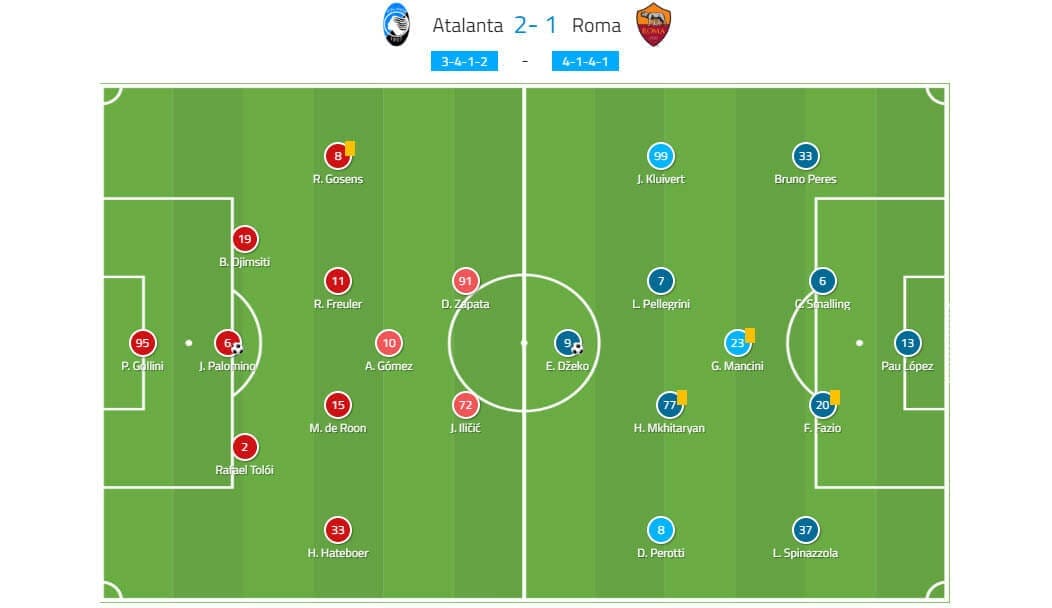
Atalanta: 3-4-1-2
Gasperini makes two changes to the side that triumphed over Fiorentina the previous week. Mario Pašalić and Timothy Castagne are withdrawn from midfield to be replaced by Hans Hateboor and Remo Freuler respectively. Top goal scorer Josip Iličić holds his place up front as he looks to better his record of 14 goals already this season.
Roma: 4-1-4-1
By way of injury and suspension, Roma was without five players heading into this game. Six changes were made to the starting XI that suffered a defeat at home to Bologna the previous week, three in midfield and three in the defensive line. Aleksander Kolarov, Davide Santon and Gianluca Mancini exit the defensive line in place of Leonardo Spinazzola, Federico Fazio and Bruno Peres. Gianluca Mancini finds another place in the starting XI as he replaces the suspended Bryan Cristante who saw red last week against Bologna. While Jordan Vertout and Cengiz Ünder make way for Lorenzo Pellegrini and Justin Kluivert.
Bruno Peres who makes his fourth appearance of the season played a total of 58 minutes across all three previous appearances Roma subsequently lost all games the Brazilian full-back featured.
Atalanta’s build-up
The Nerazzurri have earned their reputation as one of Europe’s finest attacking sides right now. It is not just what they do in the final third that matters but the dynamic style of movement in the build-up that allows their forwards to take so much reward in front of goal. Boasting a league-high xG average of 2.32 per game, Atalanta showed why they are such a force in attack, and it all starts with the build-up.
Against Roma’s mid-block and lone striker, Atalanta stretched the field horizontally and created overloads centrally by dropping central players deeper to the defensive and midfield line. To keep fluidity in the attack and play through the units quickly Atalanta’s defence play close to the first line of pressure, the Roma forwards. As Roma engage the press, Atalanta play passes forward through the gaps when they are available or then horizontally to the opposite flank, Roma’s weak side. By transferring the ball from flank to flank quickly, Atalanta creates good chances to play through the weak side, as Roma’s midfield are unable to move across in time to form a compact block.
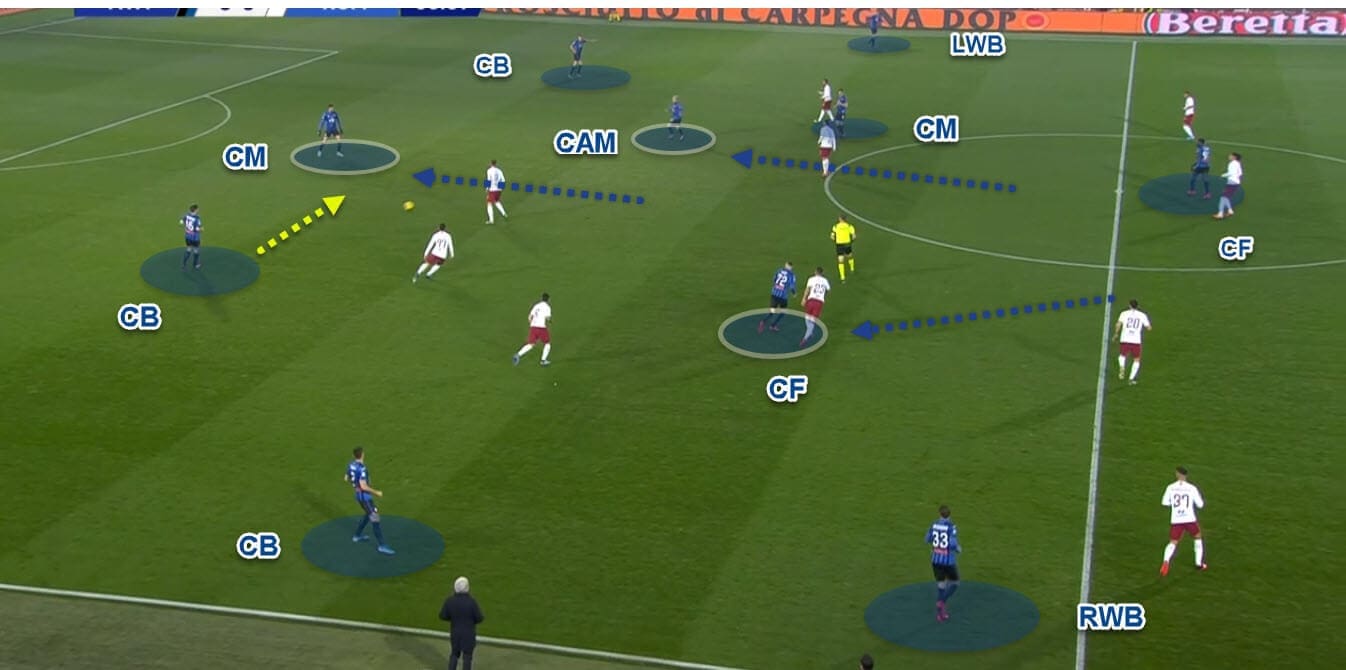
Notice this balanced shape in Atalanta’s build-up play as they are about to play ‘around and through’ the Roma press. The left and right wing-back’s serve to stretch Roma horizontally by being high and wide. The central-midfielder drops level with the centre-backs to create an overload and potentially create space in midfield by drawing in pressure. For the space that is created in central-midfield both the central-attacking-midfielder and the centre-forward drop in to offer an outlet to receive a pass and play forward.
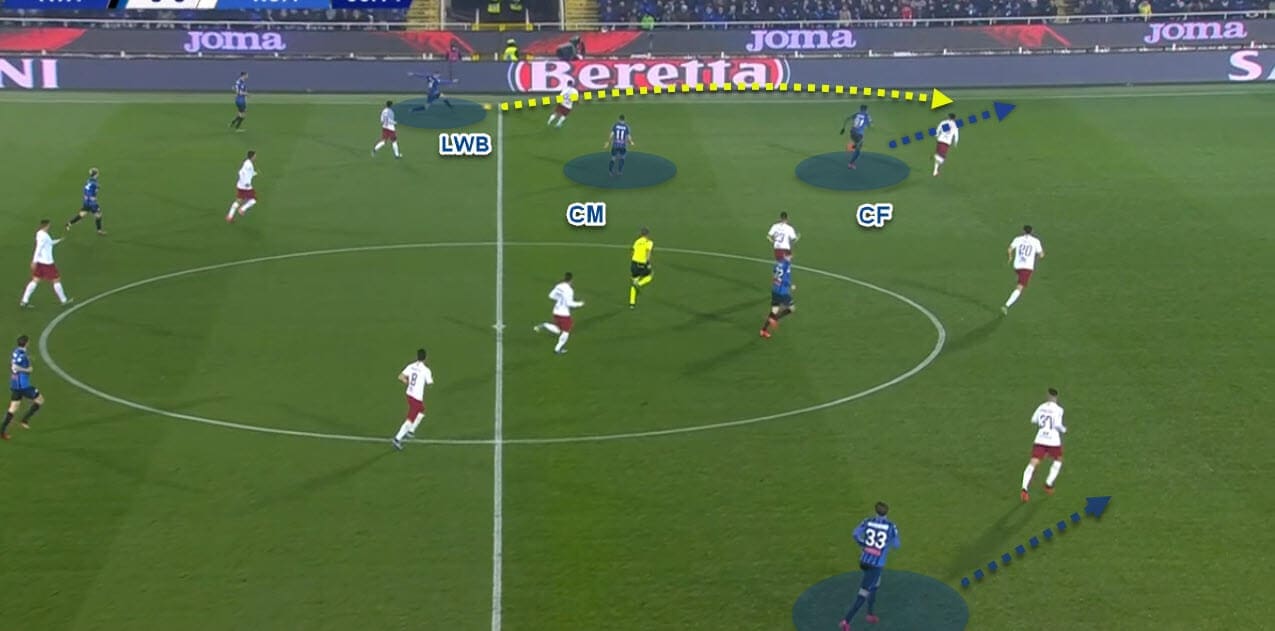
In the above image, there are many moving parts we cannot account for all at once; however, just observe the Atalanta, left-wing-back, central midfielder and centre-forward. As the play reaches the left-wing-back from the build-up, the centre-forward makes a run into the channel to receive a through ball. This movement serves to cause an imbalance in the Roma defensive line as the centre-back has to move with the Atalanta forward to deny him any progress. If the left-wing-back does not play the centre-forwards run he also has the option inside with the central-midfielder to attack or play an attacking pass to the weak side (opposite side).
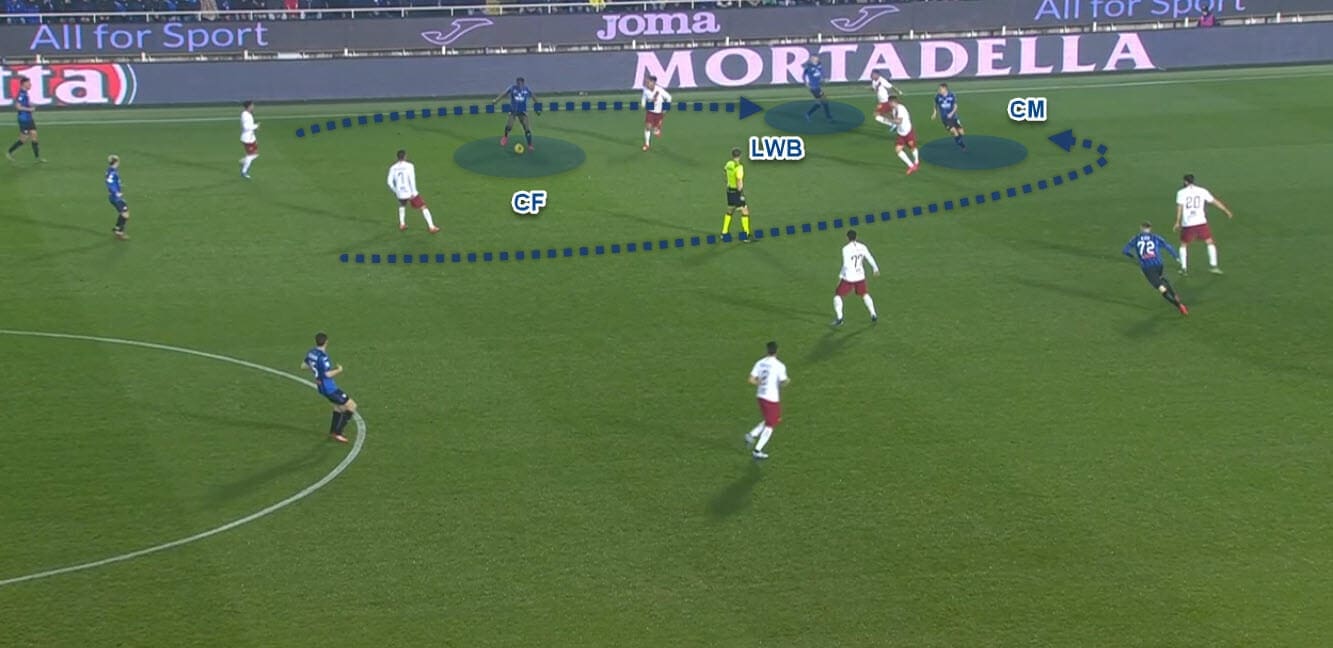
As we see above, the centre-forward receives a pass in the channel and has turned back to his safe side to link with support players. Moments later the left wing-back and the central-midfielder make runs beyond the centre-forward to offer a penetrating pass and options to further the attack.
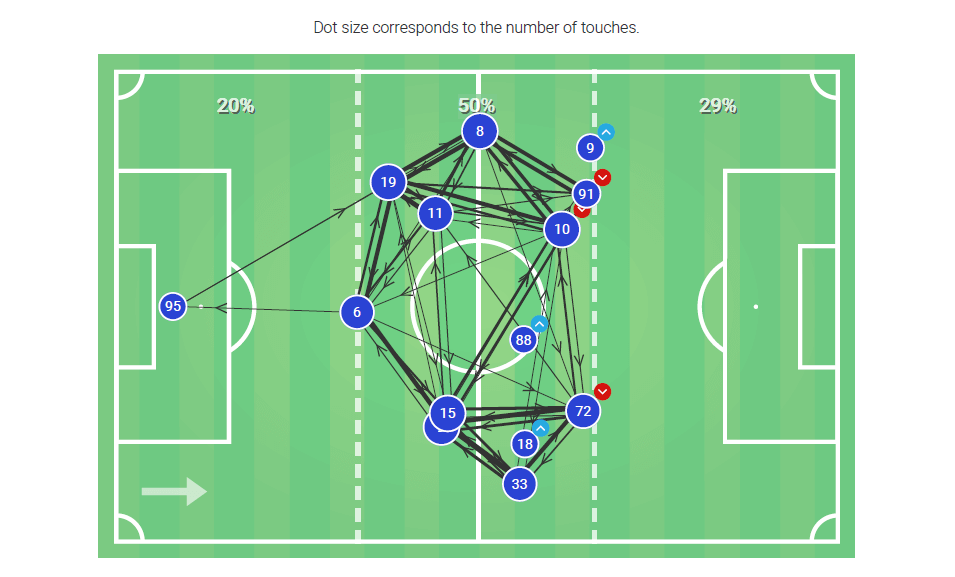
The data above shows Atalanta’s passing network in the game, the blue circles represent the player’s average positions in possession. The lines account for combinations of three or more passes. Considering the density of the lines, we can see Atalanta’s centre-backs must be comfortable to play and receive passes when under pressure.
Atalanta exploit the weak side
Although the statistics for chances created, assist or even goals will not highlight the wing-backs in the Atalanta team, they are crucial to understanding why Atalanta get so much success in the 3-4-1-2 formation. In the offensive phase, the wing-backs stretch the opponent horizontally, that we have established. However, it is their movement and positioning out of possession that often creates dangerous attacks. As Atalanta build-up an attack on one side of the field, you will observe very early that Atalanta will not try to force their way through an organised, compact block. Rather, they seek to exploit the opposite flank at it’s earliest opportunity. Considering this to be the opponent’s weak side, the wing-backs Robin Gorsens and Hans Hateboer will take up the most optimum position to receive a pass and continue an attack on the Roma backline. Here they may serve dangerous crosses into the box, cause unbalance to the defence and even supply the assist before the assist so to speak.
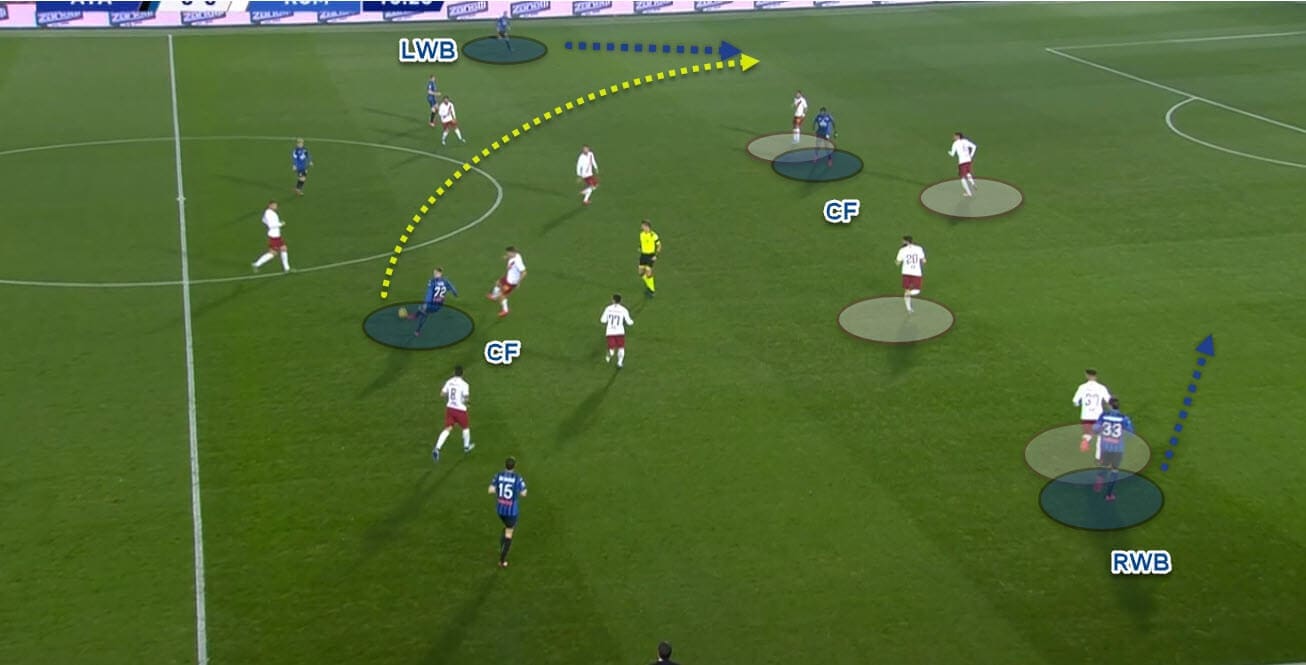
Observe in the image above, the positioning of the two wing-backs, along with the centre-forward they occupy the highest line on the field. At this moment, the centre-forward in possession has just received a pass from the right wing-back who developed a prominent attack on the right. The centre-forward plays an instinctive pass to meet the run of the left-wing back on the opponent’s weak side. When accounting for the value in this strategy, we do not just account for chances created and shots on goal but also secondary success such as corners, free-kicks and territory in the opponents final third to continue the attack.
Atalanta’s movement in the final third
Although we may not see repeat patterns of play to Atalanta’s combinations before penetration, we may understand their attacks by principle by observing their movement in the final third. The wing-backs pin the opponent’s full-backs high, one of the centre-forwards will drop deep to receive an attacking pass unmarked, while the near side centrebacks support from behind in the half-spaces. After this, we see the central midfielders make clever runs into space to offer horizontal and vertical rotations. Due to the short distances of support, Atalanta was able to keep a high tempo and fluidity in possession which, along with good movement, served to create good opportunities to penetrate. Roma found it difficult to cope with this unconventional movement which meant they needed to offer more players in the defensive phase to nullify the attack.
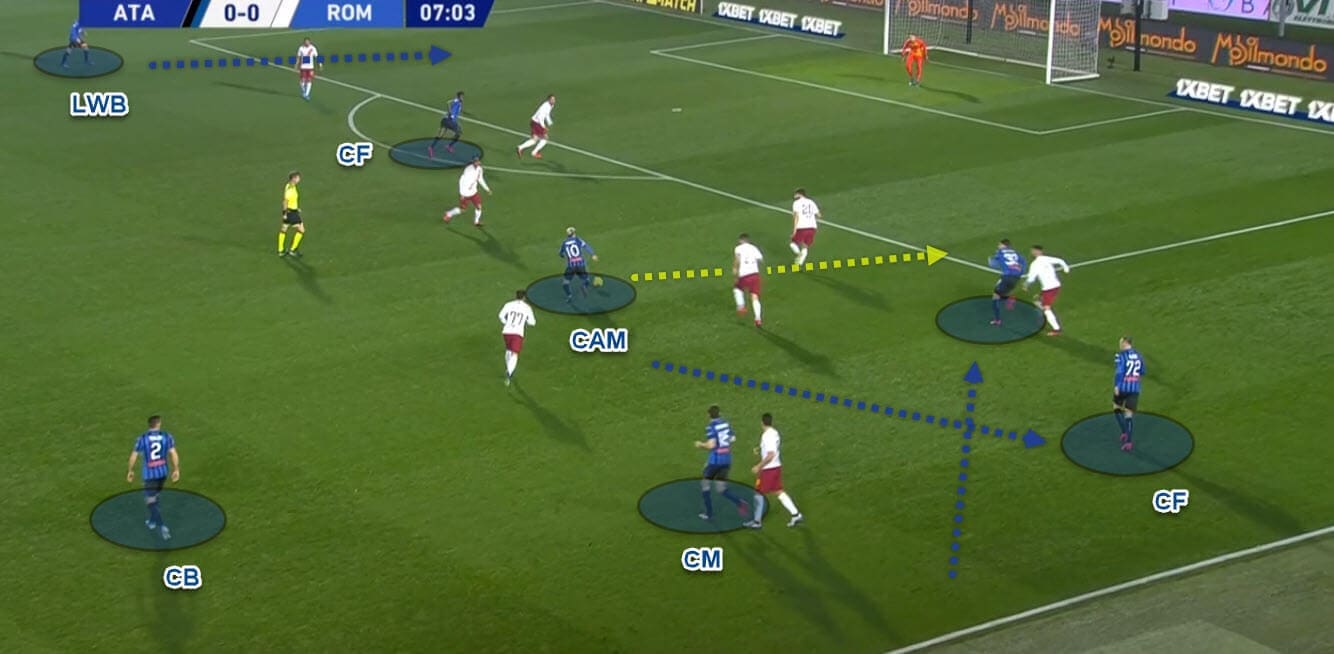
At this moment, we see the right-wing back is about to receive a penetrating pass to meet his run into the box. Only moments before this the right wing-back was offering support from deep on the touchline before an opening appeared due to Atalanta’s good movement and combination play. Notice the centre-forward Iličić moves out to the right flank to offer the width in attack.
Atalanta’s second goal on 59 minutes came by way of good movement, support and combination play on the left flank. As it almost seemed Atalanta were over-playing in the wide areas a piece of individual brilliance from M. Pašalić to receive the ball in the box with a defender on his back, turn and strike it into the top right corner. Atalanta’s movement and offensive organisation is a match for any top European side.
Roma’s attack
The Giallorossi did not have it all their own way in this affair as a side that has established a per game xG rating of 2.0 for the season they were reduced to an expected goals rating of 0.36 as they were tasked with breaking down a solid defence. We observed many changes in approach for Roma’s attack as the game progressed, moving from a patient build-up team with phases of individual flair on the wings to a team that was looking to find their target man Edin Džeko from distance moments after winning possession. Not to take anything away from the attacking prowess of this side we saw that Roma tried to adapt in attack particularly after going behind, although they were close they were unable to match Atalanta for a second goal. Let’s look at the various approaches we saw from the men in red and gold.
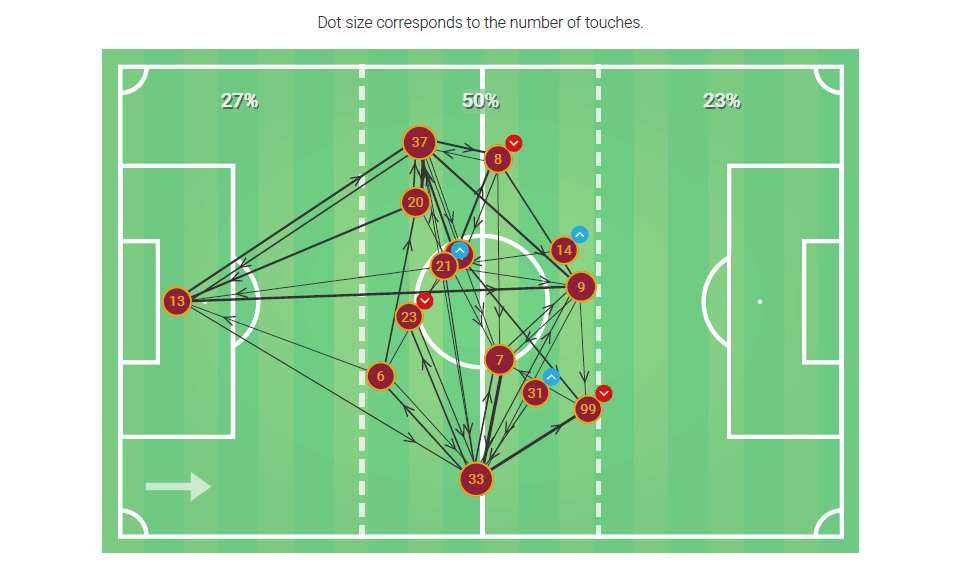
The data above shows the passing network of Roma, accounting for combinations of three or more passes. The data does show Roma have a good ability to play through the thirds and combine well in attack as although the lines are not as dense as their opponents the distribution is quite evenly balanced across all the units of the team.
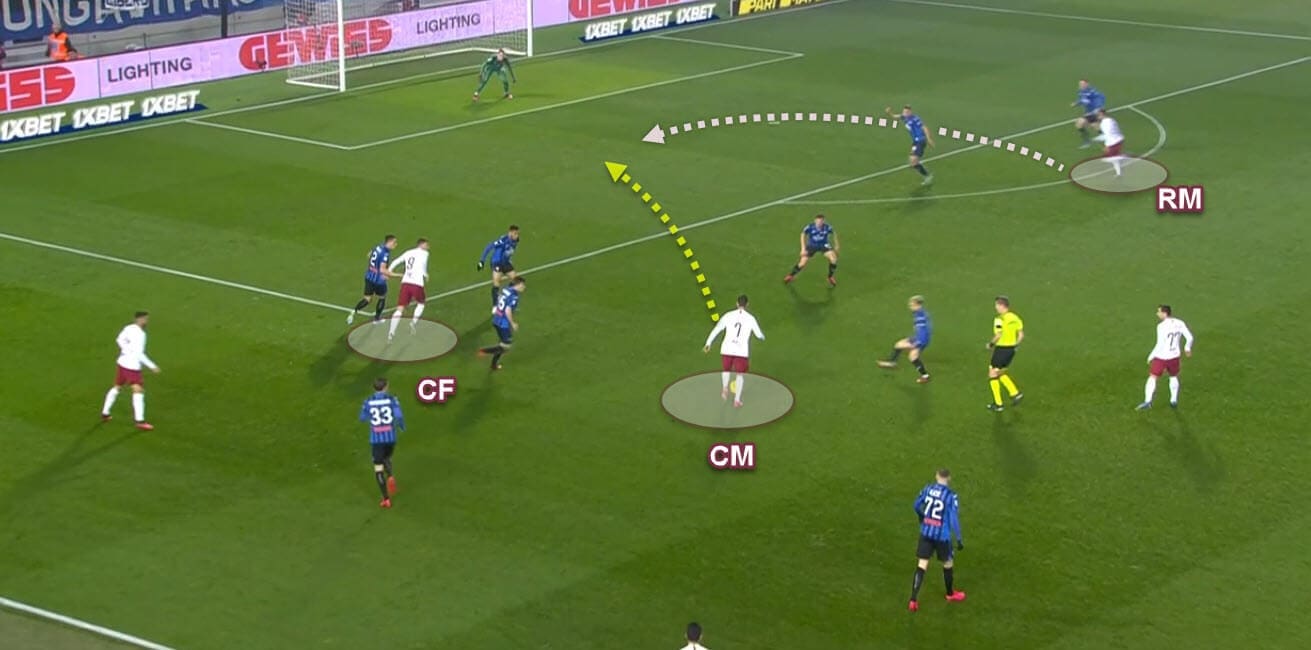
Particularly in the early stages, we saw a few prominent attacks develop in Atalanta’s final third. Showing good movement to open the defensive five, striker Edin Džeko caused unbalance in the defence by supporting a wide attack only to feed a pass inside that would then meet the run of the right-winger, Kluivert. Although Roma was unable to capitalise in this phase, this was perhaps their best-attacking opportunity from open play. The breakthrough came for the visitors on 45 minutes as Džeko forced the Atalanta centre-back in possession just outside his own box into an error, which subsequently resulted in the experienced target man driving inside and finishing low to the goalkeepers left to take his goals tally for the season to 11. Roma’s front line showed some individual brilliance in this game although due to a lack of precision in the final product, they were unable to claim any more than one goal.
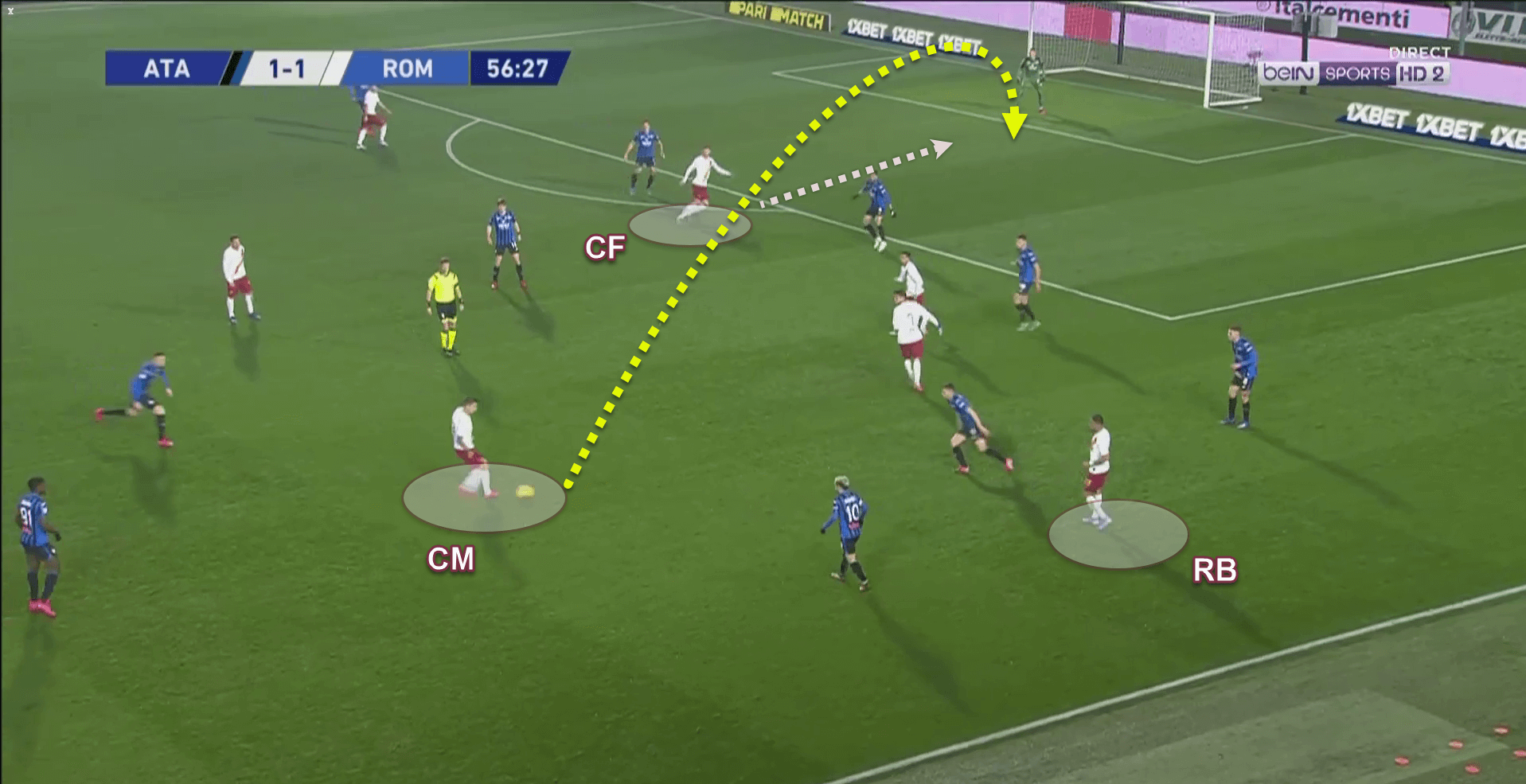
In the above image, we see Roma central midfielder play a dipped cross over the Atalanta backline into the run of Džeko. As Roma struggled to penetrate the Atalanta defence with combinations, It was certain moments like these seemed to show most promise to result in a goal. The central-midfielder receives a pass from the right-back and on his first touch plays a high lobbing cross from the half-space into the strikers run.
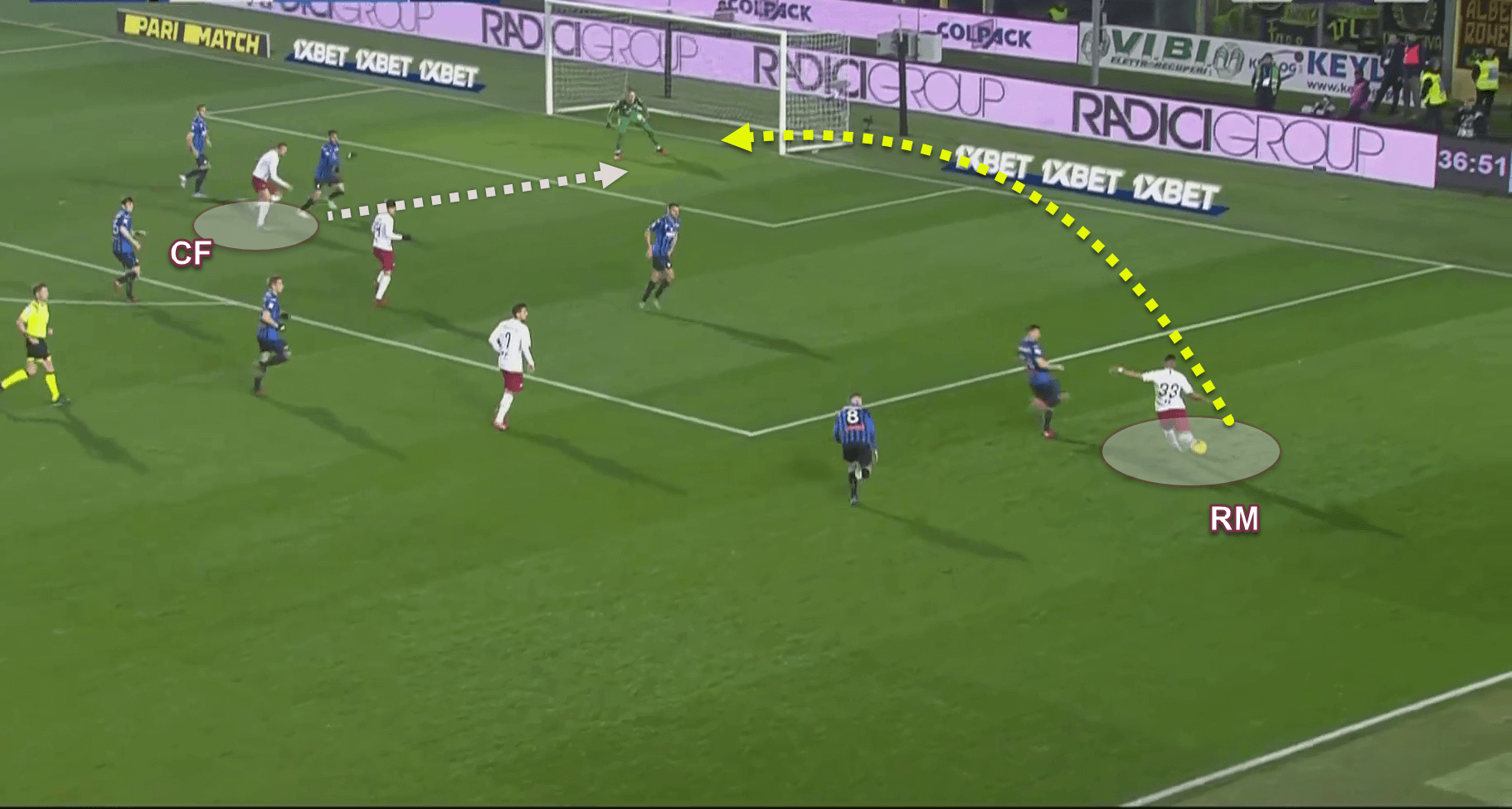
Here we also see when another crossing position Roma utilised. Fonseca’s substitutions in the second half showed that Roma was looking to get success from wide areas as Diego Perotti and Kluivert were withdrawn from the wings to allow the platform for Carles Perez Gonzalo Villar to create dangerous chances from crosses.
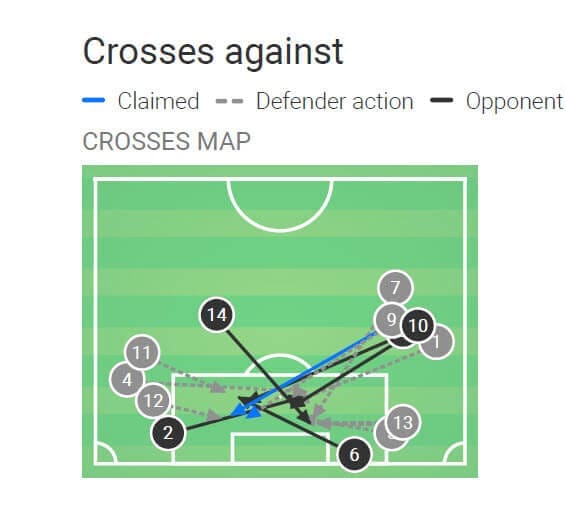
The ‘Cross Map’ above is a datasheet from the Atalanta goalkeepers player report. Here we see Roma’s crosses from open play showing the multitude of positions Roma opted to cross from. Note the darker lines signify the crosses Roma met successfully in the attack.
Atalanta’s defence
Excuse the cliché here but as we have all heard ‘a good offence is the best defence’ well when looking at this Atalanta side play, I cannot help but think that perhaps the opposite is also true, a good defence is the best offence. We have come to admire the free-flowing goal machine that is Atalanta for their style of play going forward, but once again Atalanta showed masterful defending to adapt as Roma adapted their attack. Heading into this game, Roma had an xG of 2.0 per game. By the end of the game, Gasperini’s men made sure Roma amounted no more than an xG rating of 0.36.
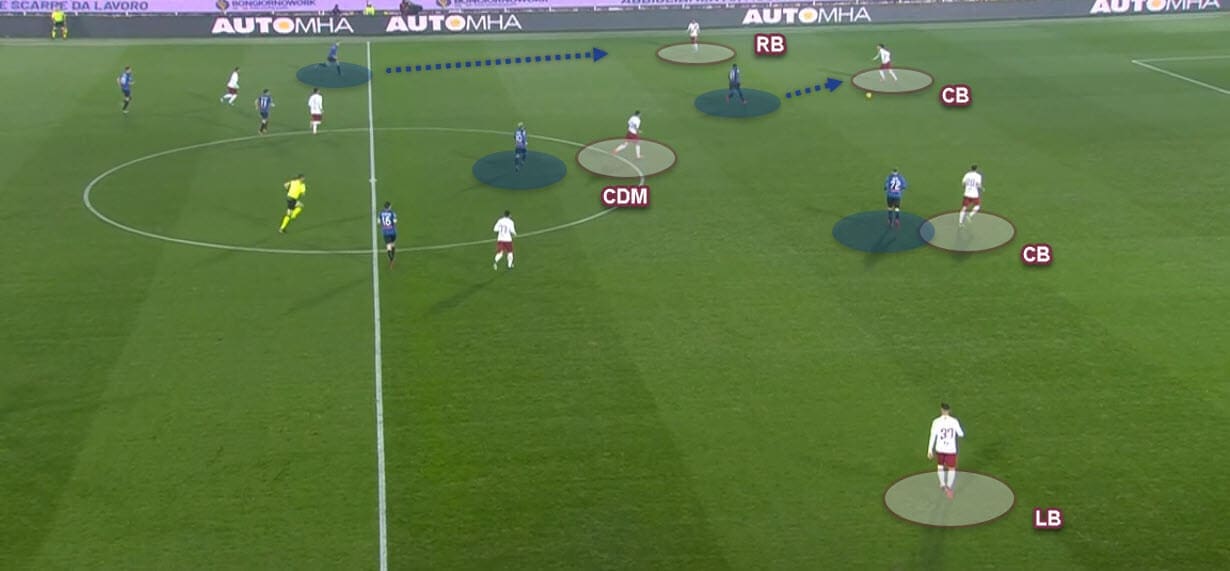
Starting with their press from the front, the Nerazzurri were efficient in how they pressed together and dropped together. As Roma played horizontally across the back four to discover openings to play forward, Atalanta knew when to engage the press, as the Roma attack was one-sided the first task was to deny transference of possession to the other side but cutting off the passing angles in the press. Secondly then as Roma were forced to play forward into midfield, the passing options were read and nullified. In the above image, the play is about to transfer to the right-back, notice how Roma do not have any overload opportunities or free players on that side of the field.
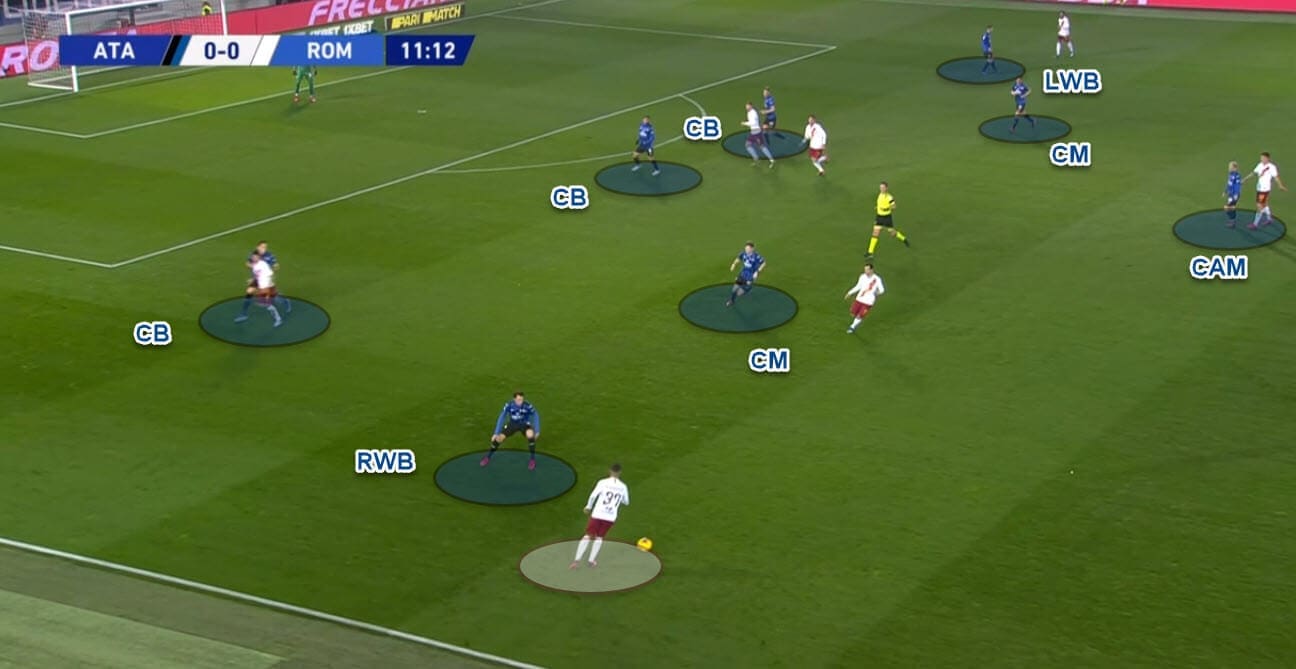
When defending in their own third the positioning of the wing-backs is crucial to allow the three centre-backs to remain balanced, central and comfortably set to deny any advancing attacks in central areas. As the right wing-back presses the ball carrier notice, he takes up a deliberate position to block the ball carrier a left-footed cross. Thus forcing the play inside where Atalanta are marking man-for-man. The right-sided centre-back follows the runner into the wide channel, and still, the Nerazzurri are centrally balanced to cover all threats in attack.
Roma’s defence
The Giallorossi were tasked with neutralising a prolific Atalanta attack. As we account for the PPDA (passes per defensive action) of 17.6, (meaning Roma made a tackle or significant disruption to the attack after an average of 17 passes from Atalanta). This is a very high figure however when we account for Atalanta’s reduced xG rating of 1.47 compared to their xG average of 2.32 then this some times tells a story of a team that forms low-block against strong possession-based opponent.
As we saw earlier from Atalanta’s passing network that the men in blue exercise a lot of patience and horizontal movement with the ball inside their own half. This helps us better understand by data alone that Roma had no interest in pressing Atalanta in their third of the field.
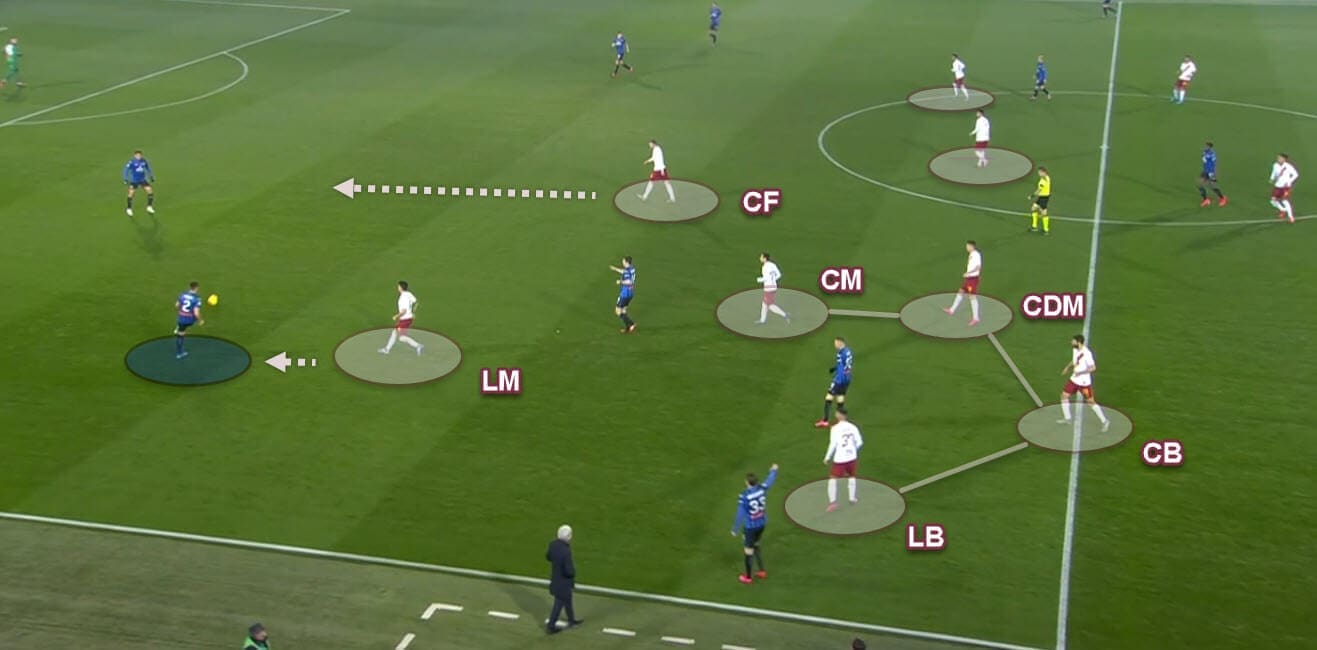
Roma would form a mid-block inside Atalanta’s half, and move with the horizontal movement of the ball. Should a wide centre-back opt to carry the ball forward, then a Roma winger would press the ball carrier. Džeko would only press the middle centre-back when he is in close proximity. The Roma full-backs and centre-backs would push high and man-mark wide players to deny Atalanta any overloads to play through. When Atalanta advanced to the halfway line in the wide channels, then Roma would look to spring a trap or pressing phase to win possession with the aim to transition effectively.
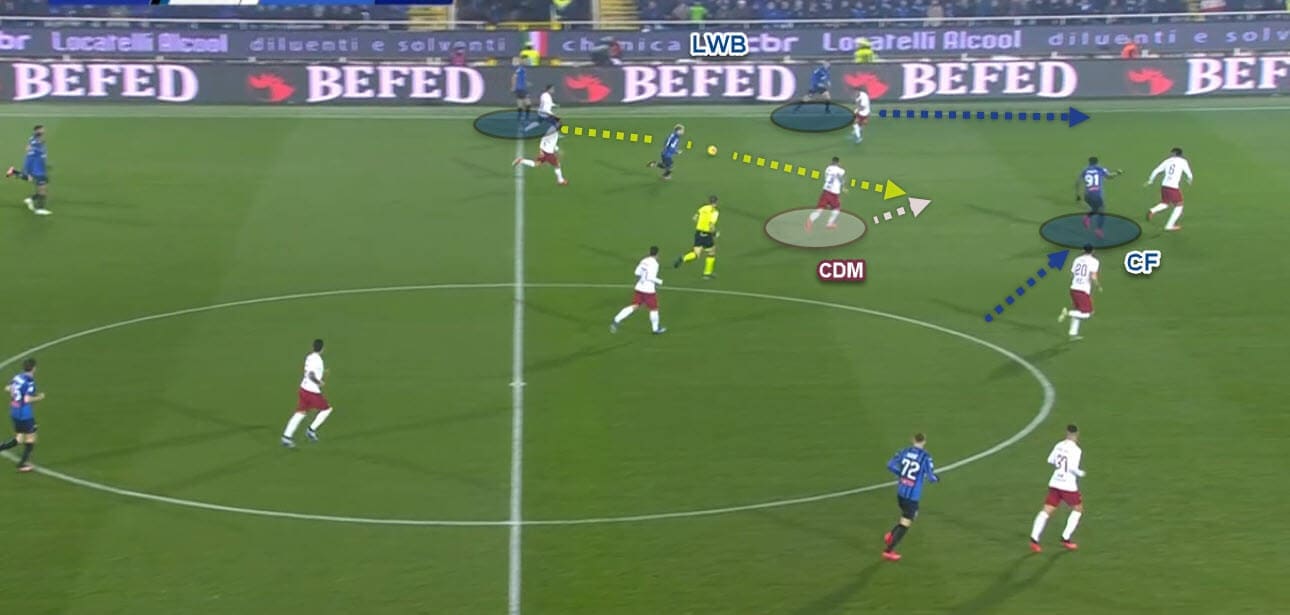
Another important component in the Roma defence, a central defensive midfielder or CDM. Mancini performed this role exceptionally well against tough opposition winning 100% of his loose ball duels and winning 71% of his defensive duels in midfield. One example of Mancini’s importance is outlined in the above image. As we see Mancini, the ‘CDM’ is sprinting to meet the pass intended to connect with the Atalanta CF. The potential for danger can be seen by observing the run of the Atalanta ‘LWB’ at the top of the image. Should the pass connect with the Atalanta ‘CF’,then he can play an attacking pass into the free space that the ‘LWB’ is attacking. However, by Mancini getting across and intercepting that first pass, the threat is ended, and the attack is nullified. Mancini played a crucial part in defending and helping his team transition quickly.
Conclusion
Assessing the performance and intensity of both teams along with the noise of the crowd you knew this match was significant for both teams, and it was going to be a big tell as to whether they would reach their European goals.
Atalanta once again showed so much resilience and mental toughness to stick to their style of play after they went a goal down before halftime. Coming out second half both sides tweaked their approach in attack and you could sense something was going to give. Atalanta returned with a well-worked corner-kick routine, as Rafael Tolói who was responsible for Roma’s opener returned to redeem himself early in the second half as he met a flick header at the back post to make it 1-1 after 50 minutes. Pašalić rounded off the scoring with a beautiful finish on 59 minutes, and Atalanta saw it through to the end.
Atalanta stays fourth in the Serie A table six points clear of fifth-placed Roma. For now, both sides will put their Seria A ambitions to one side as both have European action in their sights. Atalanta will host Valencia in the Champions League round of 16, while Roma welcome K.A.A Gent in a round of 32, Europa League tie in the same week. To track the progress of both teams and to see how they continue to perform domestically as well in their respective European campaigns, be sure to check in with us at totalfootballanalysis.com.





Comments